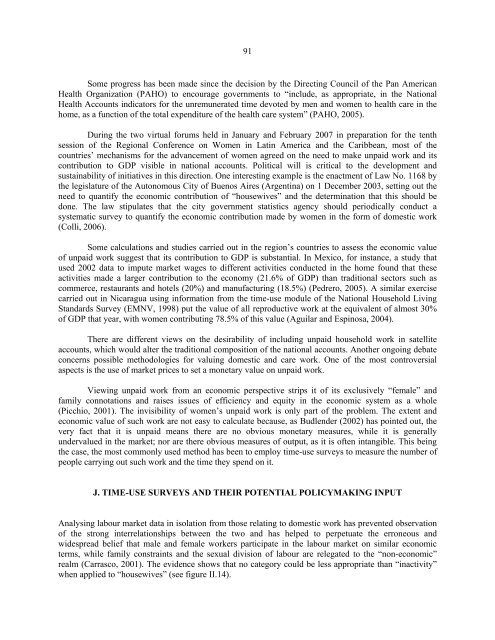Women in Latin America and the Caribbean - Cepal
Women in Latin America and the Caribbean - Cepal
Women in Latin America and the Caribbean - Cepal
You also want an ePaper? Increase the reach of your titles
YUMPU automatically turns print PDFs into web optimized ePapers that Google loves.
91<br />
Some progress has been made s<strong>in</strong>ce <strong>the</strong> decision by <strong>the</strong> Direct<strong>in</strong>g Council of <strong>the</strong> Pan <strong>America</strong>n<br />
Health Organization (PAHO) to encourage governments to “<strong>in</strong>clude, as appropriate, <strong>in</strong> <strong>the</strong> National<br />
Health Accounts <strong>in</strong>dicators for <strong>the</strong> unremunerated time devoted by men <strong>and</strong> women to health care <strong>in</strong> <strong>the</strong><br />
home, as a function of <strong>the</strong> total expenditure of <strong>the</strong> health care system” (PAHO, 2005).<br />
Dur<strong>in</strong>g <strong>the</strong> two virtual forums held <strong>in</strong> January <strong>and</strong> February 2007 <strong>in</strong> preparation for <strong>the</strong> tenth<br />
session of <strong>the</strong> Regional Conference on <strong>Women</strong> <strong>in</strong> Lat<strong>in</strong> <strong>America</strong> <strong>and</strong> <strong>the</strong> <strong>Caribbean</strong>, most of <strong>the</strong><br />
countries’ mechanisms for <strong>the</strong> advancement of women agreed on <strong>the</strong> need to make unpaid work <strong>and</strong> its<br />
contribution to GDP visible <strong>in</strong> national accounts. Political will is critical to <strong>the</strong> development <strong>and</strong><br />
susta<strong>in</strong>ability of <strong>in</strong>itiatives <strong>in</strong> this direction. One <strong>in</strong>terest<strong>in</strong>g example is <strong>the</strong> enactment of Law No. 1168 by<br />
<strong>the</strong> legislature of <strong>the</strong> Autonomous City of Buenos Aires (Argent<strong>in</strong>a) on 1 December 2003, sett<strong>in</strong>g out <strong>the</strong><br />
need to quantify <strong>the</strong> economic contribution of “housewives” <strong>and</strong> <strong>the</strong> determ<strong>in</strong>ation that this should be<br />
done. The law stipulates that <strong>the</strong> city government statistics agency should periodically conduct a<br />
systematic survey to quantify <strong>the</strong> economic contribution made by women <strong>in</strong> <strong>the</strong> form of domestic work<br />
(Colli, 2006).<br />
Some calculations <strong>and</strong> studies carried out <strong>in</strong> <strong>the</strong> region’s countries to assess <strong>the</strong> economic value<br />
of unpaid work suggest that its contribution to GDP is substantial. In Mexico, for <strong>in</strong>stance, a study that<br />
used 2002 data to impute market wages to different activities conducted <strong>in</strong> <strong>the</strong> home found that <strong>the</strong>se<br />
activities made a larger contribution to <strong>the</strong> economy (21.6% of GDP) than traditional sectors such as<br />
commerce, restaurants <strong>and</strong> hotels (20%) <strong>and</strong> manufactur<strong>in</strong>g (18.5%) (Pedrero, 2005). A similar exercise<br />
carried out <strong>in</strong> Nicaragua us<strong>in</strong>g <strong>in</strong>formation from <strong>the</strong> time-use module of <strong>the</strong> National Household Liv<strong>in</strong>g<br />
St<strong>and</strong>ards Survey (EMNV, 1998) put <strong>the</strong> value of all reproductive work at <strong>the</strong> equivalent of almost 30%<br />
of GDP that year, with women contribut<strong>in</strong>g 78.5% of this value (Aguilar <strong>and</strong> Esp<strong>in</strong>osa, 2004).<br />
There are different views on <strong>the</strong> desirability of <strong>in</strong>clud<strong>in</strong>g unpaid household work <strong>in</strong> satellite<br />
accounts, which would alter <strong>the</strong> traditional composition of <strong>the</strong> national accounts. Ano<strong>the</strong>r ongo<strong>in</strong>g debate<br />
concerns possible methodologies for valu<strong>in</strong>g domestic <strong>and</strong> care work. One of <strong>the</strong> most controversial<br />
aspects is <strong>the</strong> use of market prices to set a monetary value on unpaid work.<br />
View<strong>in</strong>g unpaid work from an economic perspective strips it of its exclusively “female” <strong>and</strong><br />
family connotations <strong>and</strong> raises issues of efficiency <strong>and</strong> equity <strong>in</strong> <strong>the</strong> economic system as a whole<br />
(Picchio, 2001). The <strong>in</strong>visibility of women’s unpaid work is only part of <strong>the</strong> problem. The extent <strong>and</strong><br />
economic value of such work are not easy to calculate because, as Budlender (2002) has po<strong>in</strong>ted out, <strong>the</strong><br />
very fact that it is unpaid means <strong>the</strong>re are no obvious monetary measures, while it is generally<br />
undervalued <strong>in</strong> <strong>the</strong> market; nor are <strong>the</strong>re obvious measures of output, as it is often <strong>in</strong>tangible. This be<strong>in</strong>g<br />
<strong>the</strong> case, <strong>the</strong> most commonly used method has been to employ time-use surveys to measure <strong>the</strong> number of<br />
people carry<strong>in</strong>g out such work <strong>and</strong> <strong>the</strong> time <strong>the</strong>y spend on it.<br />
J. TIME-USE SURVEYS AND THEIR POTENTIAL POLICYMAKING INPUT<br />
Analys<strong>in</strong>g labour market data <strong>in</strong> isolation from those relat<strong>in</strong>g to domestic work has prevented observation<br />
of <strong>the</strong> strong <strong>in</strong>terrelationships between <strong>the</strong> two <strong>and</strong> has helped to perpetuate <strong>the</strong> erroneous <strong>and</strong><br />
widespread belief that male <strong>and</strong> female workers participate <strong>in</strong> <strong>the</strong> labour market on similar economic<br />
terms, while family constra<strong>in</strong>ts <strong>and</strong> <strong>the</strong> sexual division of labour are relegated to <strong>the</strong> “non-economic”<br />
realm (Carrasco, 2001). The evidence shows that no category could be less appropriate than “<strong>in</strong>activity”<br />
when applied to “housewives” (see figure II.14).











